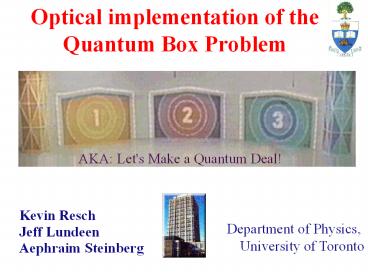Optical implementation of the Quantum Box Problem - PowerPoint PPT Presentation
Title:
Optical implementation of the Quantum Box Problem
Description:
on rail C. Post-select either A, B, C, or A B C. Compare 'pointer. states' (vertical ... Rail C. Rails A. and B. WEAK. STRONG. STRONG. So can one really ' ... – PowerPoint PPT presentation
Number of Views:21
Avg rating:3.0/5.0
Title: Optical implementation of the Quantum Box Problem
1
Optical implementation of the Quantum Box Problem
- Kevin Resch
- Jeff Lundeen
- Aephraim Steinberg
Department of Physics, University of Toronto
2
Outline
- Motivation subensembles, postselection,
and "Let's Make a Deal" - Weak measurements
- The Quantum 3-Box Problem
- An optical implementation
- Can a particle be in 2 places at 1 time?
- Summary
Funding (sources not scared to admit association
with this research)
3
Motivation
In QM, one can make predictions
(probabilities) about future observables. Can
one "retrodict" anything about past
observables? What can one say about
"subensembles" defined both by preparation
post-selection?
N.B. Questions about postselected
subensembles becoming more and more widespread
in quantum optics, quantum info, etc.
Cf. Wiseman, PRA 65, 032111 ('02) and
quant-ph/0303139
4
Pick a box, any box...
What are the odds that the particle was in a
given box?
5
Weak Measurements
6
Conditional measurements(Aharonov, Albert, and
Vaidman)
AAV, PRL 60, 1351 ('88)
Prepare a particle in igt try to "measure" some
observable A postselect the particle to be in fgt
Does ltAgt depend more on i or f, or equally on
both? Clever answer both, as Schrödinger
time-reversible. Conventional answer i, because
of collapse.
7
A (von Neumann) Quantum Measurement of A
8
A Weak Measurement of A
Poor resolution on each shot.
Negligible back-action (system
pointer separable) Mean pointer shift is given
by ltAgtwk.
9
The Quantum 3-Box Problem
10
The 3-box problem
Prepare a particle in a symmetric superposition
of three boxes ABC. Look to find it in this
other superposition AB-C. Ask between
preparation and detection, what was the
probability that it was in A? B? C?
Questions were these postselected particles
really all in A and all in B? can this negative
"weak probability" be observed?
Aharonov Vaidman, J. Phys. A 24, 2315 ('91)
11
Aharonov's N shutters
PRA 67, 42107 ('03)
12
An Optical Implementation
13
The implementation A 3-path interferometer
Diode Laser
Spatial Filter 25um PH, a 5cm and a 1 lens
GP A
l/2
BS1, PBS
l/2
MS, fA
GP B
BS2, PBS
BS3, 50/50
CCD Camera
BS4, 50/50
GP C
MS, fC
l/2
Screen
PD
14
The pointer...
- Use transverse position of each photon as pointer
- Weak measurements can be performed by tilting a
glass optical flat, where effective
q
gt
Flat
Mode A
cf. Ritchie et al., PRL 68, 1107 ('91).
15
A negative weak value
Perform weak msmt on rail C. Post-select
either A, B, C, or ABC. Compare "pointer
states" (vertical profiles).
16
Data for PA, PB, and PC...
Rails A and B
Rail C
WEAK
STRONG
STRONG
17
So can one really "detect" that a particle is in
box A and that it is in box B ????
18
Measuring joint probabilities
- If PA and PB are both 1, what is PAB?
- For AAVs approach, one would need an interaction
of the form
OR STUDY CORRELATIONS OF PA PB... - if PA
and PB always move together, then the
uncertainty in their difference never
changes. - if PA and PB both move, but never
together, then D(PA - PB) must increase.
19
Practical Measurement of PAB
Use two pointers (the two transverse
directions) and couple to both A and B then use
their correlations to draw conclusions about PAB.
We have shown that the real part of PABW can be
extracted from such correlation measurements
20
Extracting the joint probability...
anticorrelated particle model
exact calculation
no correlations (PAB 1)
21
And a final note...
The result should have been obvious... AgtltA
BgtltB AgtltABgtltB is identically zero
because A and B are orthogonal. Even in a
weak-measurement sense, a particle can never be
found in two orthogonal states at the same time.
22
Summary
- You have won the fabulous vacation!
- We have implemented the quantum box
problem and confirmed the predictions,
including the strange "negative probability." - New method for joint weak measurements
- Each photon appears to be definitely in each of
two places but never both (cf. Aharonov et al.,
Phys. Lett. A 301, 130 (2002) on Hardy's Paradox) - Much more to explore in the strange magical
land of weak measurements!































